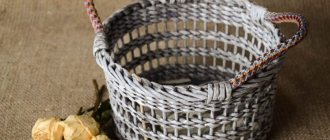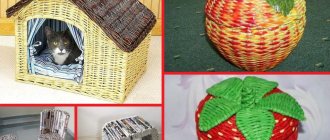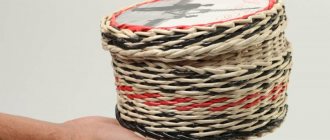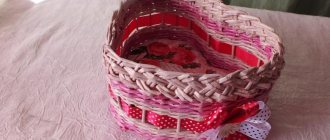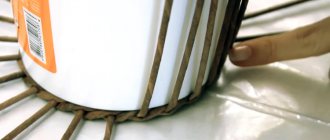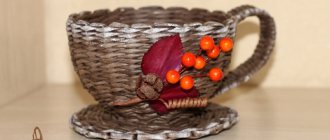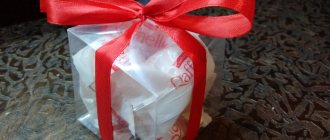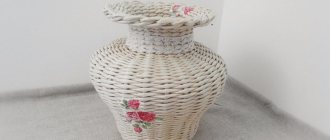Paper is the most affordable and versatile material that is used both for children's creativity and for serious design work. A paper basket can be an interesting addition to the interior, gift wrapping for a loved one, or just an excuse to do some DIY creativity with your child. In this material you will find a selection of original ideas for making paper baskets.
How to roll a newspaper tube
Recently, many master classes on making various crafts from newspaper tubes have appeared on the Internet.
However, many people still do not know about their existence. If you belong to this number, then this section is intended for you. Old newspapers need to be cut into strips 10-12 cm wide. Starting from the corner of the rectangle, roll the paper with your fingers, pressing the turns tightly so that the tube turns out to be thin and long.
Many craftsmen advise using a knitting needle for convenience, but some do not like this facilitating method, since the tubes turn out to be slightly conical, that is, by the end of winding the diameter of the product increases. To weave, the tube must be smooth and thin. Try to ensure that all the parts are the same diameter, otherwise a basket made of newspaper tubes will look untidy.
In the photo above you can see how the master rolls a thin tube out of paper with his hands. If you don’t manage to do it neatly the first time, don’t worry, with experience you’ll get the hang of twisting weaving blanks in 1 minute. At the end, coat the extreme corner of the paper with PVA glue and attach it to the last turn. Unevenness in length and edges are trimmed with scissors at the end, when many elements have been made.
Weaving a basket from newspaper tubes requires long parts, so immediately try gluing two pieces into one. Lubricate the edge of the first element with glue and screw it into the hole of the second from the end side. After hardening, weaving can be safely continued. In this way you can weave a basket the size of a person, because the tubes can be extended many times.
Painting with a bouquet
A paper basket can become the basis for an applique. Such an unusual painting can be given as a gift for any occasion or to decorate your interior. By doing it with your child, you will have an interesting and useful time.
Read also: Recipes with avocado for weight loss
Cardboard base
For beginners, it is more convenient to decorate a basket of newspaper tubes on a cardboard base. To make the bottom of the craft durable, they mainly use packaging corrugated cardboard in one or two layers. Draw the desired geometric shape on the sheet and cut out the part with scissors. Stepping 1 cm from the edge of the cardboard, use an awl to make holes at regular intervals. In our sample it is 2 cm. Then insert a newspaper tube into each hole to the middle and bend it in half, pointing upward.
The first row of weaving begins from the corner of the future basket, if it is square or rectangular. Pull a piece bent in half onto the outermost newspaper tube and twist it in an “X” shape, alternately along the entire perimeter of the bottom, going around each piece sticking up. Change the position of the halves all the time: one in front, the other at the back of the canvas. The next step is done in reverse. When you run out of paper, attach another tube to the two ends using PVA glue and continue working until the desired height of the basket. This is the simplest weaving option, which can be handled by craftsmen who are taking on such work for the first time.
Weaving baskets of different shapes
Baskets made from newspaper tubes have different shapes. Even beginners can weave various configurations with their own hands.
Square basket
Sequence of making a square basket:
- You should start by forming the bottom. To do this, take a cardboard strip and bend it in half. Punch holes in the cardboard at a distance of no more than 2 cm. Insert an extended “work cord” into the resulting holes.
- A long vine should be woven near the cardboard. Having reached the edge, turn and weave in the opposite direction. To extend the “working cord” it is necessary to re-glue the paper blanks. The bottom width may become narrower and should be adjusted to the desired size.
- Then the side walls of the braid are formed. An oblong newspaper rope is required, which is bent in half and both ends are threaded into the bottom. The tails that appear from the bottom of the bottom must be bent upward and secured. The “working cord” must be made to the desired size depending on the required height.
- To fix the sides, you need to place a heavy thing in the center, similar to the shape of the future basket. Then attach the frame tubes to it using an elastic band.
- Start weaving from the bottom of the craft. Using a long piece, weave it into one side, alternating the placement of vertical strands, placing them at the back and in front.
- At the beginning of work, the tip of the “working cord” remains, which can later be used as one of the components of the frame. It allows you to form an odd number of vertical blanks. After the next row, the unoccupied edge should be braided. The procedure of weaving the sides is carried out in a circle until a basket of the required size is obtained.
Rectangular basket
To form the bottom of a rectangular basket, you need to cut out a template of the intended size from cardboard, place it along the edge of a twisted tube, and secure the structure with clothespins. Then lay newspaper blanks across the base so that each bundle in turn goes from below or above the base, and adheres to the desired grouping of weaving.
For some period, the craft should be covered with another paper cord and secured with clips. The bottom will become like a comb, and then you need to weave in new pieces, observing a checkerboard pattern and forming the desired density. If the bottom becomes strong enough, you can remove the clothespins because it can hold its shape on its own.
When the base is woven, ray-like strips remain, which in the future will be used as the basis of the frame, and with their help you can form frame walls. If the tube runs out, you need to add a new one. When decorating the edges, unnecessary ends are cut off and glued inside.
Punnet
To create a round-shaped product using the rope method, you need to follow the following steps:
- Take six strips of newspaper and use clothespins to make a solid surface.
- Repeat this manipulation again and fold both parts crosswise.
- Then put the paper vine into the work. Bend the workpiece in half and place its tip in the place where the cross is formed.
- Next, a circular bottom is woven. The work cord must be bent with each turn, which is made at an angle of 90 degrees. This maneuver, which forms a ring, should be repeated 4 times, and then fixed with clamps.
- The sides are woven in pairs. Place an oblong double paper vine exactly under the created bottom. The ends of the paired strands should be secured to the basket.
More options for weaving a round bottom
Option 1
The step-by-step photo below clearly shows the order of laying out the tubes on the table surface before starting work.
First, place three elements side by side vertically and horizontally with a “+” sign, then place a similar number of pieces on top with the letter “X”. To prevent the newspaper tubes from slipping or slipping during further work, press down the middle of the workpiece a little. You can use an iron or a regular rolling pin.
Weaving is done in a circle. Bend one tube in half and place three tubes standing in a stack. Press down the fold with your fingers. Next, we weave a basket of newspaper tubes in pairs, that is, we visually divide the three elements into pairs and go around them with halves of the main part in the manner described above. When a little material remains, make a coupling: glue one more to each end of the tubes and continue weaving to the desired diameter. You can make a cardboard template or measure the bottom using a regular glass container.
Option# 2
Circular weaving of a basket from newspaper tubes can also be done with large stitches. Getting started is completely consistent with the previous option, already described above. The main tube is highlighted in white in the photograph. It is bent, as usual, in half and crossed around packs of three parts, without separating them in pairs. To continue working on the round basket of newspaper tubes once the desired diameter is reached, lift all the elements perpendicular to the table surface upward.
There are baskets in the shape of a truncated cone, that is, with an expansion at the top, then you will need to insert a template inside the workpiece. It is most convenient to make it from corrugated packaging cardboard, already familiar to the reader. To prevent the tops of the parts from bending under the weight of the paper, they are attached to the template with clothespins. And the main newspaper tube, which is used for the actual weaving, continues to be twisted around each vertically protruding knitting needle. For convenience, you can temporarily remove the clothespin, stretch the tube and attach the clothespin to the previous place.
Oval basket
An easy way to create a basket:
- to create the bottom you need to take several newspaper blanks and weave them together in the form of an oval.
- fasten them by tying them together
- Having formed the base, you need to weave it according to the usual method.
- Having made the desired diameter of the bottom, wrap it and lift the tubes up.
- Secure the strands with clamps and continue weaving.
- After finishing the work, secure the edges in the usual way.
Corner basket
When weaving corner crafts from newspaper bundles, it is advisable to follow these rules:
- To make stands, it is advisable to use a vine from a whole sheet of paper for printing or use magazine source material. Soft blanks will not be able to withstand the braid.
- When designing a basket, to form a uniform bottom, you should place a weight on it, paying special attention to the corners of the product.
- For painting, it is necessary to accurately calculate the required amount of acrylic coating, because if you add another shade, the color will be far from ideal.
Original ideas
Of course, the possibilities of creating “flower baskets” using the appliqué method are not limited to this. It is useful to consider the option of DIY crafts for children 6 years old and primary school age. Here the emphasis is on developing the eye and aesthetic taste, fine motor skills and imagination. Snowdrops are used as a basis. To work you will need templates; the flowers are made from white and yellow paper circles.
They start by getting the petals. To do this, fold the circles in half, then in half again. Next, it remains to fold them right and left towards the middle, round them a little and cut off the right edge. The last step is to unwrap the part. Repeat all this 6 more times.
Then it remains:
- make the central part of the flowers;
- in the middle of the circle with petals, add a yellow circle with a cut edge and the same white circle;
- lightly fluff the center;
- weave a basket of yellow and green stripes;
- trim it;
- assemble the parts of the application together.
There is another way:
- cut off a wide green strip;
- fold the remainder (one section slightly larger);
- cut a smaller piece;
- make a round blank for the basket and grass;
- glue flowers to the base;
- make a basket handle and put it in place.
Weaving from newspaper tubes for walls
As soon as you start weaving products, the patterns will become clear to you. Having gained a little experience, you will learn how to reconstruct the weaving method by looking at the photo. For beginners, we recommend starting with the simplest patterns. This is a rope, and then a pigtail. It won't take much time to master them.
Even a beginner can weave such a basket from newspaper tubes.
Rope
To master the technique of weaving from newspaper tubes, you will need about five to seven stands. To begin with, you can attach several pieces of thick wire to some kind of stand (a piece of dense foam plastic, for example).
This is what weaving looks like live on a “simulator”
The following is the weaving process:
- We take two tubes and place them crosswise between the two outer posts. It turns out that one tube is in front of the work, the other is behind.
- Holding the tubes at the intersection with one hand, bend them with the other, going around the next stand. As a result, the tube that was in front turns out to be behind, the one that was behind turns out to be in front.
- We bend it again, going around the next rack and so on until the end of the row.
That's all - this is a method of weaving a “rope” from newspaper tubes. Already using this technique you can do the simplest things. The product is dense and durable. One important point: for this pattern to look normal, there must be an odd number of racks.
By changing the “starting” location of the tube, we get a different pattern in appearance
If you want to make it a little more complicated, you can take two tubes and go around two posts at a time. But then you need to calculate the number of racks so that the second row is offset - then the pattern will turn out to be interesting. No less interesting are two ropes directed towards each other, and not woven in one direction.
Chess
Checkerboard is another simple weaving method. To do this, you need to take two tubes, placing them one above the other.
- We fix the first pair to one of the racks (just hold the edges with your finger).
- We bring them forward, making sure that they remain one above the other.
- Let's start it back.
- Forward again and so on...
- We take the second pair, secure them behind the next rack (move one rack forward), but above the first row.
- Further actions are similar - forward/backward.
- Using the same principle, we weave the following rows.
This way you can weave a basket, tray and many other products. In terms of density, the product is not as strong as with the previous weave.
In combination with the already known rope we get an interesting product
If you combine the two methods described, you get a rather interesting product. And if the transition is also decorated in a different color, it will be even prettier.
Drawing the template
Work on the “Basket with Flowers” craft (2nd grade) begins with making a template. They make it on white cardboard, and only then transfer it to any colored sheet. First, cut out a rectangle of the desired size, then round off all the corners. A smaller oval is drawn inside the workpiece with its center shifted upward.
The handle area is thinner than the basket itself. All that remains is to use scissors to cut out the inner oval along the contours. To do this, make a hole at any point and insert the tip of the scissors into it. All that remains is to cut to the marked contours and then move along them to the end until the inner oval falls out. Next, we’ll figure out how to make a basket using threads in “Technology” in 2nd grade.
Shutdown
In order for the product to look neat, it is necessary, firstly, to remove the working tubes, and secondly, to somehow form the edge and do something with the stands.
Some weaving elements are more complex. It’s best to master them after you’ve made a couple of simple baskets
We fix the working tubes
First you need to secure the working tubes. Usually they are hidden in the weave - in the nearest binding. For this operation you will need a knitting needle or a long wooden skewer.
- Having retreated down three or four rows, we insert the skewer so that it comes out not far from the working tube.
- Bend the tube and place it on a skewer. We carefully place the entire structure in the place where the skewer was inserted.
- We cut the tube as close to the weave as possible.
- We repeat from the second.
- We straighten the weaving from newspaper tubes so that the scraps are not visible.
This is a simple and reliable way to secure the working tubes. Their ends are hidden in the weaving, but are securely fixed and clamped. For those who are just starting to master paper weaving, this is perhaps the best option.
Weaving the edge - the main technique
Next, you can begin to close the edge. There are many different ways - more or less complicated. The simplest one is to do the same as with the workers, but bend them inside the product. But then the edge is not very beautiful. If you want to make it more aesthetically pleasing, you can try the “rod” edge. It is not too difficult for beginners to master, and it looks interesting.
To close the edge with a “rod”, you need an auxiliary tube or you can take a skewer or knitting needle. With its help, we bend the first post to the right, bring it behind the next post and bring it forward. We bend it to the right in the same way, hook it behind the next one and bring two more posts forward. In total, we have three bent.
From now on we will always work with the leftmost tube. We take it, move it to the right, go around the two posts in front (one bent, one standing), take it behind the third, bring it forward and bend it.
We cut it with pliers so that 8-9 mm of tube remains behind the stand. To fix this trim, we bend the first of the standing posts to the right, pressing the trimmed edge. Again we have three tubes (bent) at work. Again we take the left one and repeat everything again.
A side is gradually formed that covers the top of the weave. We repeat all these steps until three stands remain: two bent and one standing. It’s easy to track this moment, it’s important not to miss it. This is where you need to be careful. If everything is done correctly, it will be impossible to find the place where the work begins/ends.
Final chords
When three racks remain uncovered, you need to make sure that the newspaper tubes are laid in the same sequence and in the same direction, so that they lie the same way as before. We take out the auxiliary tube or skewer with which we began to close the edge.
Again we take the leftmost tube, in front we go around the last standing post and then, according to the previous weaving algorithm, we need to lead it behind the next post. This stand is already bent and secured. This is the one with which they began to close the edge. We insert the tube from the back, slip it under the first curved post (it’s more convenient with a skewer) and pull it forward, laying the tube like the rest. We cut it off.
Further according to the algorithm, it must be covered with the previous stand. In this case, it's the last one standing. We bend it, bring it behind the weaving and push it behind the cut-off post.
Now there are no standing racks, only three working ones remain. They must be laid in the same way as those that are already secured. We take the far left one, it must be pulled under the third post. Look carefully. This is the first stand that does not have a cut tube near it. Stretch, lay, cut.
We lay the left tube along the top, covering the tubes we just laid. We start it from the back, pull it under the counter, in front of the laid tube.
We repeat the same operations with the next leftmost one. It must be placed behind an “empty” stand, near which there is no cut tube. This stand is located to the right of the one we just worked with. Here you can’t do without a skewer - you need to slip a newspaper tube under the two already laid (look at the photo).
We lay the tube on top, hiding the cut one above. We start it from the back, put it on a skewer and pull it out. Holding it with your fingers, we rock it from side to side so that there is a place for it and it “lies down.” We cut it off.
All that was left was a newspaper tube sticking out. We start it behind the third rack. It’s not difficult to find your way: under the first two there are already scraps of the ones that were just laid. We insert the skewer under the laid turns and bring it out near the bent post.
Using a skewer, we bring the last rack out and lay it out so that it lies the same way as the others. Now it can be trimmed. The edge of the basket is ready and it is impossible to find where the row begins and ends.
Ideas for making a crochet basket for Easter
When I was preparing this collection, of course I couldn’t leave out the knitted toys. Indeed, in skillful hands, whole masterpieces can be made from yarn, knitting needles or crochet.
So, you can knit a case for an egg and the egg itself)) Or an excellent chicken.
But what a motley hen!!
Or an idea with interesting Easter bunnies. It looks very original.
How do you like these bunnies?? Well, just lovely!!
Or these delicate baskets with Easter characters.
But here is a similar job to rabbits made of fabric, only here you need to knit them.
And I also selected diagrams for you, it was very difficult to find them of good quality, but I tried, I hope you like it and find it useful.
This option is suitable for storing sweets or can be used as a box.
The yarn makes very cool works, and most importantly original ones; no one will definitely have such crafts.
Master class: a simple basket made from newspaper tubes
A simple model of a basket made from newspaper tubes is created with your own hands in this way:
- Use a knitting needle to twist 30 strands of newspaper strips, 10 cm wide.
- Using a jar, cut out 2 circles from cardboard. Flatten the tubes for the frame on one edge by 3 cm and glue them to one of the circles with the flattened side.
- Glue the second circle on top of the first so that the ends of the paper cords are between them. Raise the blanks up and secure with an elastic band.
- Next, you should take the newspaper edge flattened on one side and pass it behind the tube located next to the right, pulling the edge further and bringing it in front of the next paper strip. To form the bottom row, you need to alternate the workpieces in this way, putting others into the hole when they are finished.
- Weave to the desired level, then trim off the excess ends and treat the basket with glue.
Decorating crafts
You already know how to make a paper basket with your own hands. Now let's look at its decoration using the following example. In the photo, the craft has sides in the shape of squares. Each part is additionally covered with strips of bright glossy paper in a contrasting color. Its edges cut with a special serrated knife look beautiful. The strips are longer and, after gluing them at the ends, give the basket more volume. To hide the joints, the bottom and top of the basket are covered with edging made of paper of the main color.
The handle is also cut out of decorative paper and decorated with two satin ribbons of different widths. After attaching it to the sides of the basket, make a voluminous rose from a light ribbon on one side and decorate it with a bow folded from a thin blue ribbon. The finished craft looks impressive and looks strong.
Sources
- https://e-ipar.ru/podelki/podelki-iz-bumagi/korziny-iz-bumagi
- https://handsmake.ru/korzinka-svoimi-rukami-iz-gazetnyh-trubochek.html
- https://modernplace.ru/pletenie-korzin-iz-gazetnyh-trubochek/
- https://TopSapozhok.ru/pasxalnye-korzinki-svoimi-rukami-iz-bumagi.html
- https://handskill.ru/432161a-kak-sdelat-korzinochku-iz-bumagi-instruktsiya
A complex basket made of newspapers. Step-by-step instruction
A low, practical basket is made as follows:
- For the bottom you will need 13 newspaper tubes. 5 of them need to be placed side by side, and the remaining 8 should be laid out crosswise on top.
- Next, we braid the top in the form of a braid with one piece of paper.
- When the paper rope runs out, it should be extended.
- Weave the bottom in this way to the required size.
- Having completed forming the base, you should bend the tubes upward and braid them again.
- Having created 4 rows of walls of the future product, fix the main strips on the sides with clothespins and then form the basket. The entire craft is braided in two pieces.
- At the end, the edge is made with a figured volumetric weave.
- Hide and glue the excess ends.
- Pull out the clothespins, paint and varnish the basket.
How to make a pen
The easiest way to make a handle for a basket:
- You will need 4 long flexible ropes. For elasticity, it is worth spraying them with a spray bottle.
- Use clothespins to mark the places on the basket where the handle will be attached.
- Pass the tubes through the rows already made so that they are of equal length.
- Having obtained two rows of four strands, you should cross the parts. As a result, an even braid-curl should form.
- Make spirals until you get a handle of the desired length.
- Thread the braid through the braided model.
Middle design stage
For the round center of the flower, cut out a ring. The thread is wrapped around the thin side and tied in a knot. Continue winding the yarn turn by turn until you fill the entire surface with yarn.
For the center of the flower, choose bright shades of thread. At the end of the work, also tie a knot on the back side of the workpiece. This will be the inner ring for attaching the petals. However, you need to make one more outer middle. The manufacturing method is similar and will not be repeated, but make the hole in the center smaller so that the elements from below are not visible.
What to paint with?
It is better to color the tubes in advance. To do this, you need to immerse them in a container of shallow depth, and then fill them with the selected dye, water-based wood stain will do, for 3-5 minutes. Dry the products on a wire rack or mesh. A brush will help distribute the paint evenly. It is easier to tint finished baskets using a spray bottle.
You can get a blue tint using regular blue dissolved in a water-alcohol base. The color can be varied individually. When using wood stain, the color match will be as follows:
- maple - red-orange;
- oak - brown-red;
- ebony gives a dark gray tone;
- larch – yellow;
- fern – green;
- mahogany – pink.
When using stain, the easiest way to paint the workpieces is to dip them directly into the container with the composition, from each end. This way the products will also be painted on the inside. The paper has time to become saturated with color, but does not get wet.
It is better not to pre-tint newspaper tubes. During initial painting, they still retain visible remnants of printing ink. When repeated, they become brittle. The problem can be solved by applying varnish tinted in the desired colors after weaving, in 2-3 layers.
Tags
colored paper and double-sided green paper colored paper colored paper green paper paper white colored paper cut out colored paper from colored paper made from colored paper made from colored paper with flowers colored double-sided hand motor skills using your own hands from your own hands to make with your own hands to make with your own hands a basket with your own hands we will make decor we made in Make a beautiful one How to make an airy one with your hands to make a basket with your hands to make a basket
photo commentsmaterialsbeautifulchildren's corrugated tubesflowerhandleshelp in a way to gluedecorationsnewbestproductsnearshapesdifferentanswerfor examplestepbysteptubepaperreadform
